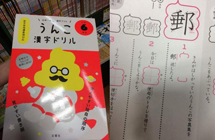太拼啦!为吸引小学生学汉字 日本推出《便便汉字练习簿》
|
许多日本人对于“便便文化”有着近乎执着的喜爱,日本商家经常会推出一些便便形状的恶搞商品吸引顾客,比如“便便美食”、“便便笔记本”等猎奇商品。最近,有日本出版商甚至把便便应用在了日文汉字教材中,以此激发小学生学习汉字的兴趣。这本《便便汉字练习簿》不仅问题和例句离不开便便,甚至连练习写汉字的空格都是可爱的便便形状。 As many Japanese parents and teachers will attest, getting young children to write and memorise hundreds of kanji characters can be a thankless task. But a new series of study books has generated a surge in interest in stroke order, radicals and alternative pronunciations – all thanks to an enduring obsession among children of a certain age: poo.
Scatology-based study in the form of the Unko Kanji Doriru (poo kanji drill) has proved enormously popular among the country's primary school pupils, with their parents' blessing, since the series of books appeared in March. The drills, complete with tips from Professor Poo – an emoji-like turd with glasses and a handlebar moustache – have so far sold 1.83m copies. "I want to make boring study more fun," the publisher, Shuji Yamamoto, told the Mainichi Shimbun newspaper. Yamamoto, a 40-year-old former Lehman Brothers employee who founded his own publishing company seven years ago, said: "I'm an extremely ordinary person. So I know what most ordinary people want. I know what is likely to sell." Written Japanese comprises 2,136 "regular-use" Chinese-based characters – or kanji – and the hiragana and katakana phonetic scripts. Hiragana is made up of 46 base characters that are often used as particles or to inflect verbs and adjectives. The same number of basic katakana symbols are commonly used to write foreign loan words. Japan's children – among the most numerate and literate in the world – are supposed to be able to read and write 1,006 kanji after six years of primary school education, starting at age 6. To help them reach that goal, and prepare them for memorising the remaining 1,130 characters before they complete their formal education at 15, the book includes the word "poo" in every one of its 3,018 sample sentences. "Adults may raise their eyebrows, but for children, the word 'poo' is magical and makes things fun," the book's author, Yusaku Furuya, told Kyodo news. While the kanji are arranged thematically to aid memorisation, some of the example sentences border on the surreal. A drill used to teach the kanji for "meeting" reads: "We are starting a poo meeting now." Hinata Shibasaki, seven, is one of the many children who loathed rote learning at school but are now fully fledged kanji converts. "It's funny because poo appears everywhere," he told Kyodo. "I used to hate studying kanji, but I got hooked on this book." |









